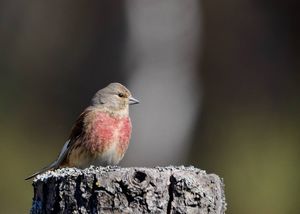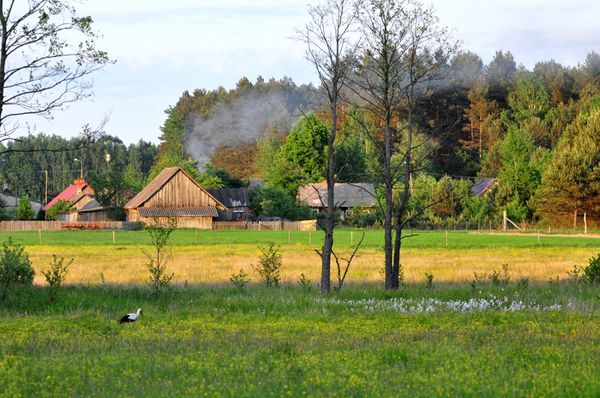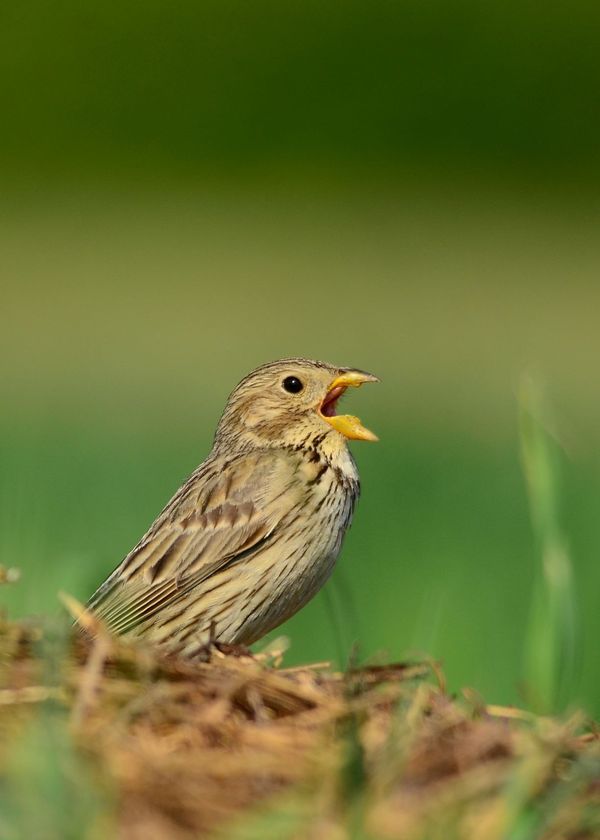 LINKED PAPER
LINKED PAPER
Village modernization may contribute more to farmland bird declines than agricultural intensification. Rosin, Z.M., Pärt, T., Low, M., Kotowska, D., Tobolka, M., Szymański, P. & Hiron, M. 2021 Conservation Letters. doi: 10.1111/conl.12843 VIEW
Houses, barns and stables stand in the shade of old deciduous trees; they are accompanied by orchards, garden plots, ponds and patches of blooming vegetation. Cattle and horses graze in adjacent pastures, whereas poultry (hens, ducks, geese) walk freely around farms. The whole picture is full of life and colours. Isn’t it how many of us imagine an idyllic countryside? Such traditional villages used to be home not only for people and domestic animals but also for farmland wildlife. For centuries farmland birds accompanied humans benefitting from a multitude of nesting sites and food resources in and around rural homesteads. When searching for causes of farmland bird declines, we used to focus on changes in agricultural fields and non-crop habitats, and we forgot about the centre of farmland, rural human settlements. Changes in villages have been as dramatic as in surrounding fields and have occurred at the same time as agricultural intensification. Rural settlements have become more and more urbanized –many old farmsteads disappeared in favour of single big industrial-like farms or were replaced by modern houses and lawns. These changes have had a dramatic impact on farmland birds.

Figure 1 Heterogeneous structure of old rural settlements enriches farmland with various nesting sites, shelters and food resources © Darek Świtała.
Old villages are hot-spots of bird diversity in agricultural landscapes
Based in Poland, that is still on its way to modernise rural areas, I have had plenty of chances to observe traditional rural settlements. What I like most about them is not only their appearance that resembles descriptions from classic belles-lettres, but also amazingly rich bird life. In my first paper linked to this topic, together with co-authors I showed that villages are the richest environments when focusing on the number of individual birds compared to agricultural fields, forest, ecotones (zone between field and forest) and towns (Rosin et al. 2016). Number of bird species in villages was almost as high as in ecotones. What made villages so valuable is old farmsteads and homesteads. We found that old properties (built before 1989) had higher species richness and abundance than new ones (built after 1989), and farmsteads (linked to agricultural production) had higher species richness and abundance than homesteads (used only for living). Half of the recorded 33 bird species preferred old farmsteads, while only one species was linked to new homesteads.
What have we done to farmland birds’ homes?
Modernisation of villages in central-eastern Europe started after the fall of communism when the official economies began to grow. The availability of food items in stores has explosively increased and farming for own needs became uneconomic. Cities have expanded and assimilated nearby villages (the “urban shadow” effect). New houses were built in villages and more and more rural people adopted urban lifestyles. Central-eastern European countries followed western Europe in this respect (Antrop 2000). Enormous financial support from the European Union after 2004 drove more changes. Big, modern farms aimed at mass production have developed and outcompeted small farmsteads. Old buildings have been renovated for energy-saving purposes. These changes have left less and less nesting opportunities and food resources for farmland bird species.
New and renovated buildings are well-insulated having potential nesting places highly reduced compared to old buildings. In the second ‘village’ paper we showed that increasing the share of new and renovated homesteads in villages is strongly negatively associated with abundance of species that nest in buildings (Rosin et al. 2020). House Sparrow (Passer domesticus), Black Redstart (Phoenicurus ochruros) and many other species have lost their nesting sites due to the renovation of old buildings and find no alternative in new ones. Moreover, barns and pigsties either became empty or were modernised to become big, closed, hygienic animal production facilities, depriving Barn Swallows (Hirundo rustica) of their nesting sites. It also means that the availability of invertebrates is reduced, an important food source for many farmland birds during the breeding season (e.g., Møller 2001). No poultry in backyards and well-secured cropping means no access to grain, another important resource for farmland birds (Šálek et al. 2015).

Figure 2 Corn bunting and many other farmland species search for insects around farmsteads, e.g., in manure heaps © Darek Świtała.
Is village modernisation a missed key factor of farmland bird declines?
Many bird species that nest in villages forage in adjacent agricultural fields and semi-natural habitats, while species that breed in crops and non-crop habitats search for food in villages. Rural settlements are a widespread and integral part of farmland and modernisation has occurred across most of the continent and other parts of the world. In my latest study (Rosin et al. 2021) we confronted the impacts of village modernisation and agricultural intensification on farmland bird diversity in villages and agricultural fields. We showed that modernised villages and their surrounding agricultural fields had 50-60% fewer birds than those in and around comparable older villages. Based on model predictions we found that modernisation contributed more to farmland bird declines than agricultural intensification in both village and crop environments.
We analysed three different ecological sub-groups of farmland birds: species nesting in buildings, non-crop habitats (associated with mid-field trees or shrubs) and open fields. Building nesters and non-crop species observed in both villages and adjacent crops strongly decreased with village modernisation. Non-crop nesters (e.g. Greenfinch (Chloris chloris), Corn Bunting (Emberiza calandra) and Yellowhammer (Emberiza citrinella)) observed in fields were strongly negatively related with agricultural intensification and decreased with modernisation more within big fields and where open residual habitats (e.g. remnants of wetlands) were abundant.
Field nester responses to village modernisation was also highly dependent on the level of agricultural intensification. Even species that do not depend on village structures may be affected by modernisation; probably through interspecific interactions such as predation and competition that may change with village modernisation.
We can bring home back
Compensating for nesting sites and food resources that were lost due to modernisation is relatively easy and cost-effective. Hanging nest boxes on buildings and trees, constructing canopied platforms (e.g., for Barn Swallows) on farm buildings and additional feeding should be performed where modernisation occurs. Supporting small family-based farmsteads and encouraging rural people to grow vegetables for their own needs are further ideas. By keeping rural houses and farmsteads bird-friendly, we can help save farmland birds and we help ourselves to reconnect with nature and benefit from services that birds deliver to us such as pest control and aesthetic sensations.
References
Antrop, M. 2000. Changing patterns in the urbanized countryside of western Europe. Landscape Ecology 15: 257-270. VIEW
Møller, A.P. 2001. The effect of dairy farming on barn swallow Hirundo rustica abundance, distribution and reproduction. Journal of Applied Ecology 38: 378-389. VIEW
Rosin, Z. M., Hiron, M., Żmihorski, M., Szymański, P., Tobolka, M., & Pärt, T. 2020. Reduced biodiversity in modernized villages: A conflict between sustainable development goals. Journal of Applied Ecology 57: 467-475. VIEW
Rosin, Z. M., Skórka, P., Pärt, T., Żmihorski, M., Ekner-Grzyb, A., Kwieciński, Z., & Tryjanowski, P. 2016. Villages and their old farmsteads are hot spots of bird diversity in agricultural landscapes. Journal of Applied Ecology 53: 1363-1372. VIEW
Šálek, M., Havlíček, J., Riegert, J., Nešpor, M., Fuchs, R., & Kipson, M. 2015. Winter density and habitat preferences of three declining granivorous farmland birds: The importance of the keeping of poultry and dairy farms. Journal of Nature Conservation 24: 10-16. VIEW
Top right: Common Linnet (Linaria cannabina) may lose its food, weed seeds, because patches of unmanaged vegetation often disappear from modernized villages. Photo credit: Darek Świtała.
If you want to write about your research in #theBOUblog, then please see here.


